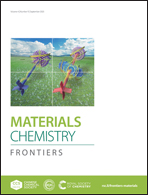Interpenetrated tunnel routes in silicon/carbon hollow sphere anodes to boost their lithium storage†
Abstract
Prolonging the cycle life of silicon-based materials at large current is particularly meaningful for the achievement of advanced high-power lithium ion batteries. However, the sluggish kinetics induced by inferior electronic conductivity and structural stability in the process of repeated discharging/charging is the main obstacle for the achievement of high-performance Si-based materials. Herein we present interpenetrated silicon/carbon composite hollow spheres through an ultrafast microwave assisted synthesis method and subsequent magnesiothermic reduction process. Benefiting from the synergistic effects originating from the hollow nanostructure with interconnected porous shells and carbon permeation, the interpenetrated Si/C composite anode achieves high-rate and ultralong-life lithium-storage capability. The discharge capacity reaches up to 930.7 mA h g−1 at 5.0 A g−1 after 1550 cycles. More notably, especially at 10.0 A g−1 after 2000 cycles, the Si/C composite still delivers a high reversible capacity of 522.2 mA h g−1. Systematic analyses verify that the interpenetrated structure effectively accelerates the ion diffusion and charge-transfer kinetics. More remarkably, a prototype lithium-ion full cell comprising the Si/C composite anode is endowed with excellent properties. Our findings provide profound understanding of the kinetic relationship between the structure and performance, as well as inspiration for future design of nanoarchitecture electrodes for next-generation rechargeable batteries.



 Please wait while we load your content...
Please wait while we load your content...